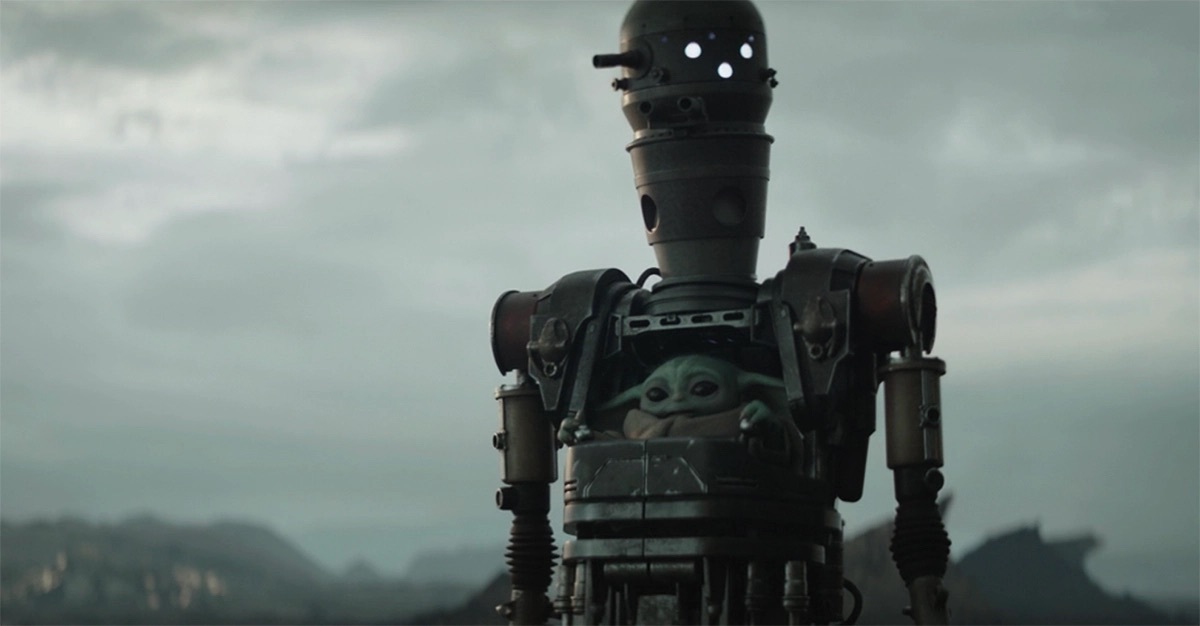Grogu’s New Mobility Aid Re-opens the Discussion About Disability in ‘Star Wars’
Grogu is, for all intents and purposes, a disabled character.

Upon seeing Grogu piloting IG-12 as a mecha/mobility aid and speech device in the most recent episode of The Mandalorian, I had the (probably delayed) realization that the Mandalorian foundling/former Jedi youngling is, for all intents and purposes, a disabled character.
While being capable of great feats of physicality through the Force, Grogu requires a mobility aid when traveling long distances, usually in the form of his hover bassinet, a backpack, or most recently, IG-12. He cannot speak through traditional means and requires either an interpreter (as done by Ahsoka Tano) or external technology to communicate with others. The scene where Grogu tests out IG-12 seems to be not only an exploration of the mecha’s abilities but also of Grogu asserting his independence through this mobility aid. For the first time, he can communicate with Din Djarin and others directly and is not limited to observing the world from his bassinet. Grogu also uses this agency to stop Mandalorian infighting, showing how he differs from other warriors.
I honestly shouldn’t be surprised by this; Star Wars has always had a complicated yet fascinating relationship with disability. Luke and Anakin Skywalker are two of the most prominent disabled protagonists in sci-fi/fantasy and it’s Luke’s ability to empathize with Anakin through this shared trait that ultimately saves them both. Mark Hamill has shared stories about fans with disabilities finding strength and comfort in the franchise. At the same time, Obi-Wan Kenobi said Darth Vader was “more machine than man,” likening his use of prosthetics to being an unfeeling machine.
Star Wars also does frequently fall into the trope of depicting villains as being disfigured and/or disabled. An episode of The Clone Wars indicated that General Grievous chose to replace his biological body as a means of improving himself and competing with the physical capabilities of Jedi Knights, possibly linking his enhancements to the use of steroids to get a competitive edge against an opponent. Darth Maul and Savage Opress also use prosthetic limbs after being injured by Obi-Wan Kenobi, though they were “evil” before they were disabled.
Author Ada Hoffmann has a solid breakdown of disability representation in Star Wars up to 2016, especially when it comes to comparing disabled heroes with disabled villains and how they’re portrayed and how Chirrut Imwe and Saw Gerrera, while providing representation, do also reinforce disability stereotypes.
So when did Star Wars’ relationship with disability improve?
Personally, I think Star Wars Rebels was the start of the shift. In the Season 2 finale, Kanan Jarrus was blinded by Darth Maul and was clearly struggling to adapt months after the injury. While he is able to use the Force to help him navigate battlefields, the show has little details of Kanan needing to feel where things are and occasionally stumbling when dealing with elevation.
Youtuber Oakwyrm has an excellent video essay about how Kanan’s disability is not perfect representation by any means (the ending with him regaining his sight is especially insulting), but it is a step in the right direction for exploring disability in Star Wars. Something that the saga has continued to do in the shows since Rebels.
The Clone Wars season 7 introduced the Bad Batch and reintroduced Echo who was now disabled with prosthetics that allow him to hack into computer systems. While there was a brief concern that Echo was still under the control of the Separatists, they quickly show that Echo, while changed, is still himself and in control of his prosthetics.
Fennec Shand from The Mandalorian and Book of Boba Fett received cybernetic enhancements to her abdomen after she suffered a near-fatal shot. Book of Boba Fett also introduced the Mods, a local gang of cyborgs who upgrade their bodies just as they do with their bikes. Boba Fett goes so far as to apologize for a potential microaggression concerning the language of their enhancements, though the Mods shrug it off, seeing their cybernetics as a point of pride. Even Boba Fett’s constant use of the Bacta tank indicates he still has some chronic pain from a hard life as a Bounty Hunter.
Many of the shows also explore invisible disabilities like PTSD and the psychological cost of fighting in wars. Captain Rex and other surviving clones are shown to struggle with coming to terms with the end of the war, to the point where they arguably have some self-destructive tendencies. The fact that clones are often seen as disposable also echoes some veterans’ experiences with a VA that won’t get them the help they need.
The exploration of disability in Star Wars is still a work in progress. For some reason, Echo’s disability has also left him white-washed and Kanan Jarrus had his blindness “fixed” in the moments before his death. But the galaxy is ever-expanding and that also means there’s room for growth in disabled representation.
If you’re interested in learning more, I highly suggest the embedded video essays and/or Elisa Shaholli’s essay about “Disability in a Galaxy Far, Far Away: A Mythology of Villains, “Obsessive Avengers,” and Complex Embodiments in Star Wars.”
(Featured Image: Lucasfilm/Disney)
Have a tip we should know? tips@themarysue.com